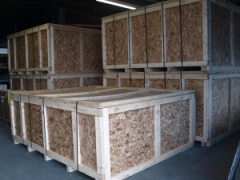Machinery
| Infobox on Machinery | |
|---|---|
| Example of Machinery |  |
| Facts | |
| Origin | - |
| Stowage factor (in m3/t) | - |
| Humidity / moisture | - |
| Ventilation | - |
| Risk factors | See text |
Machinery
Description
A machine is a tool that consists of one or more parts, and uses energy to achieve a particular goal. Machines are usually powered by mechanical, chemical, thermal, or electrical means, and are frequently motorized. Historically, a powered tool also required moving parts to classify as a machine; however, the advent of electronics technology has led to the development of powered tools without moving parts that are considered machines.
A simple machine is a device that simply transforms the direction or magnitude of a force, but a large number of more complex machines exist. Examples include vehicles, electronic systems, molecular machines, computers, television, and radio.
Shipment / Storage / Risk factors
According to weight and size various forms of packing may be used.
Lesser weights may be packed in cardboard cartons with components wrapped in oiled paper, plastic sheets or open end bags or polystyrene moulded forms, corrugated paper and the like. Heavier units may be carried in wooden crates or cases.
If cartons become wet, immediate remedial action should be taken to open the cartons and check the contents as damp or increased humidity may cause rusting or oxidation and discolouration of the contents.
If cases are lined and waterproofed there should be some means of ventilation to allow evaporation of any moisture which may form in the case to escape, otherwise the contents of the case could sustain damage from moisture which would attack polished or bright surfaces. In the event of cases timber construction being used, special heed should be paid to ensure that the timber employed is seasoned, as green timber or timber with a high percentage of resinous matter will create moisture and possible damage. Damages of this type can easily be confused with ordinary water damage.
In the carrying of heavy machinery, whether in container, case or open frame, particular attention should be given in the event of damage to ascertain whether the strength of the timbers and fastenings and internal packing or bracing is adequate to prevent internal movement and to withstand normal transit handling.
When machines are bolted to the base of cases or containers, there should be some allowance for play in movement. It has been known for the timber to swell due to moisture, thus exerting through the holding bolts sufficient pressure to fracture the castings.
The vibration of bright parts in close proximity can cause ‘fretting’, the rubbing together of two surfaces, producing an oxide formation, not unlike rust deposit, but different in its form.
When machines or components have enamelled surfaces, marking of the surfaces can be cause by pressure or rubbing against corrugated paper used to line cases. Note should be taken as to whether the bright or unprotected parts of machinery have been protected with rust preventative prior to shipment.
There are on the market special compounds for the protection against rust of various types of machinery and metallic components, and where complaints are received of rust damage prompt treatment by a dewatering oil or similar product will prevent any rust from spreading. Generally speaking the products referred to are basically an oil with a drying ingredient. If such products are unavailable, an alternative is to dry the machinery as rapidly as possible and apply an oil or grease immediately, thus sealing the metal from the atmosphere. Timely action may do much to prevent aggravation of damage arising from delay and/or improper treatment.
Machinery in Freight Containers – Inadequate packing may lead to damage of bearings, which may not be noticed until the machine is started up, leading to irreparable damage. Heavy condensation on long ocean voyages may also lead to corrosion, which may be beyond repair. There is no magical cure for condensation although understanding its origin and taking precautionary measures can certainly reduce it. Under certain climatic conditions complete prevention can be extremely expensive.
There are three conditions which must exist at the same time before condensation can occur within an enclosed unit:
a) A source of water vapour
b) A temperature difference and
c) A pathway that enables the water vapour to move from the source to the cold surface.
These are general requirements under which condensation can occur, i.e., in a warehouse, a ship or a container.
Tests carried out on rust to establish whether it was caused by sea water or not can be inconclusive. Boiling a rust sample component in distilled water cannot be expected to be as precise as other, more detailed, metallurgical tests if facilities are available locally. It is also advisable to test attachments to the subject of the inquiry, labels, wrappings, consignment notes etc. for the test purpose.
If there is no evidence that rusting was caused by rain, it might equally have been caused by condensation which can occur within the closed freight container: or by high humidity in the atmosphere. Where possible, experts should be employed to supervise the packaging and inspect goods before dispatch to ensure adequate precautions are taken.











